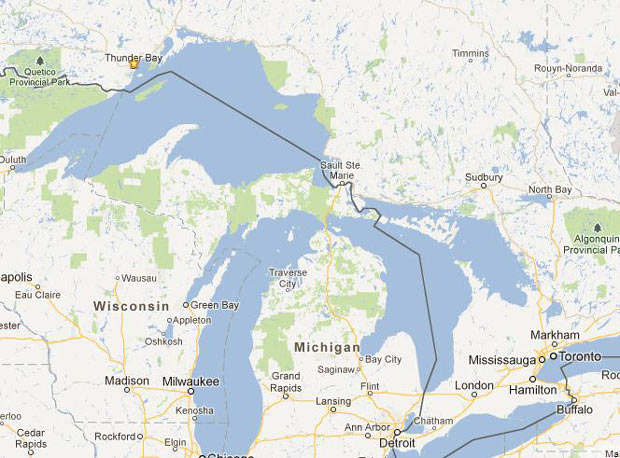
Millbrook, NY – North America’s freshwater lakes are getting saltier due to development and exposure to road salt. A study of 371 lakes published today in the Proceedings of the National Academy of Sciences reports that many Midwestern and Northeastern lakes are experiencing increasing chloride trends, with some 44% of lakes sampled in these regions undergoing long-term salinization.
The study is the first large-scale analysis of chloride trends in freshwater lakes. It was conducted by a team of fifteen researchers as part of the Global Lake Ecological Observatory Network (GLEON) Fellowship Program, an initiative that seeks to train the next generation of freshwater scientists and practitioners.
Lead author Hilary Dugan, a limnologist at the University of Wisconsin-Madison and former Cary Institute of Ecosystem Studies Postdoctoral Fellow, explains, “We compiled long-term data, and compared chloride concentrations in North American lakes and reservoirs to climate and land use patterns, with the goal of revealing whether, how, and why salinization is changing across broad geographic scales. The picture is sobering. For lakes, small amounts of shoreline development translate into big salinization risks.”
Chloride trends in 371 freshwater lakes were analyzed. Each lake was larger than 4 hectares in size with at least 10 years of recorded chloride data. The majority of the lakes (284) were located in a North American Lakes Region that includes Connecticut, Maine, Massachusetts, Michigan, Minnesota, New Hampshire, New York, Ontario, Rhode Island, Vermont, and Wisconsin.
Increased Road Salt Use
Since the 1940s, the use of road salt to keep winter roads navigable has been escalating. Each year, some 23 million metric tons of sodium chloride-based deicer is applied to North America’s roads to melt away snow and ice. Much of this road salt washes into nearby water bodies, where it is recognized as a major source of chloride pollution to groundwater, streams, rivers, and lakes.
To gauge road salt exposure, the research team assessed road density and land cover within a 100- to 1500-meter buffer around each of the 371 study lakes. Roadways and impervious surfaces such as parking lots and sidewalks are reliable proxies for road salt application because as developed areas, they are susceptible to high levels of salting and runoff.
Results were clear: roads and other impervious surfaces within 500 meters of a lake’s shoreline were a strong predictor of elevated chloride concentrations. In the North American Lakes Region, 70% (94 out of 134) of lakes with more than 1% impervious land cover in their 500-meter buffer zone had increasing chloride trends. When results are extrapolated to all lakes in the North American Lakes Region, some 7,770 lakes may be at risk of rising salinity.
If current salinization trends continue, many North American lakes will surpass EPA-recommended chloride levels in 50 years. Within this study, 14 North American Lakes Region lakes are expected to exceed the EPA’s aquatic life criterion concentration of 230 mg/L by 2050, and 47 are on track to reach chloride concentrations of 100 mg/L during the same time period.
Co-author Sarah Bartlett, a graduate student at the University of Wisconsin-Milwaukee, explains, “These results are likely an underestimation of the salinization problem, as a number of regions with heavy road salt application, such as Quebec or the Maritime Provinces of Canada, had no long-term lake data available.” Co-author Flora Krivak-Tetley, a graduate student at Dartmouth College, added, “It is also extremely difficult to obtain rates of road salt application both through time and across regions. Better application data would allow us to more accurately forecast ecosystem health.”
In lakes, elevated chloride levels have been shown to alter the composition of fish, invertebrates, and the plankton that form the base of the aquatic food web. Aquatic species richness and abundance can decline, and in extreme cases salinization can prevent lakes from mixing – causing low oxygen conditions that smother aquatic life and reduce water quality.
The study’s authors recommend that best lake management practices recognize that shoreline management extends well beyond a lake’s perimeter. While many states and municipalities acknowledge the importance of shoreline management, they note that zoning regulations are often only enforced within 300 meters, and many lakes lack the monitoring programs needed to adequately track lake health.
Coauthor and Fellowship advisor Kathleen Weathers, an ecosystem scientist at the Cary Institute of Ecosystem Studies and co-chair of GLEON, comments, “In the North American Lakes Region – where road salt is a reality – roads and other impervious surfaces within 500 meters of a lake’s shoreline are a recipe for salinization. We need to manage and monitor lakes to ensure they are kept ‘fresh’ and protect the myriad of services they provide, from fisheries and recreation to drinking water supplies.”
A lake’s chloride status may also provide a window into the ecological health of its watershed. Co-author Samantha Burke, a graduate student at the University of Waterloo, adds, “Unlike flowing streams and rivers, water resides in lakes for long periods of time. This makes them vulnerable to pollution from their watersheds and good early warning indicators of environmental disruption.”



